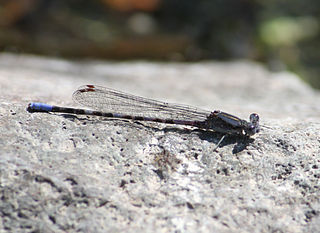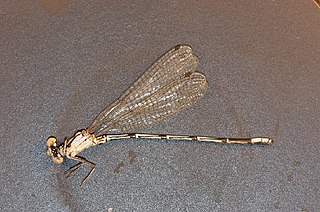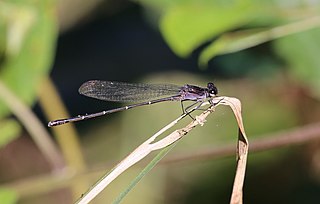
Argia is a genus of damselflies of the family Coenagrionidae and of the subfamily Argiinae. It is a diverse genus which contains about 114 species and many more to be described. It is also the largest genus in Argiinae. They are found in the Western Hemisphere. They are commonly known as dancers. Although the genus name comes from Ancient Greek: ἀργία, romanized: argia, lit. 'laziness', dancers are quite active and alert damselflies. The bluer Argia species may be confused with Enallagma species.

Argia sedula, the blue-ringed dancer, is a species of narrow-winged damselfly in the family Coenagrionidae. It is found in Central America and North America.

Argia bipunctulata, the seepage dancer, is a species of narrow-winged damselfly in the family Coenagrionidae. It is found in North America.

Argia munda, the Apache dancer, is a species of narrow-winged damselfly in the family Coenagrionidae. It is found in Central America and North America.
Argia tarascana, the Tarascan dancer, is a species of narrow-winged damselfly in the family Coenagrionidae. It is found in Central America and North America.

Argia immunda, the Kiowa dancer, is a species of narrow-winged damselfly in the family Coenagrionidae. It is found in Central America and North America.

Argia cuprea, the coppery dancer, is a species of narrow-winged damselfly in the family Coenagrionidae. It is found in Central America, North America, and South America.

Argia oenea, the fiery-eyed dancer, is a species of narrow-winged damselfly in the family Coenagrionidae. It is found in Central America and North America.

Argia extranea, the spine-tipped dancer, is a species of narrow-winged damselfly in the family Coenagrionidae. It is found in the Americas.

Argia alberta, the Paiute dancer, is a species of narrow-winged damselfly in the family Coenagrionidae. It is found in North America.

Argia lacrimans, the Sierra Madre dancer, is a species of narrow-winged damselfly in the family Coenagrionidae. It is found in Central America and North America.

Argia vivida, the vivid dancer, is a species of narrow-winged damselfly in the family Coenagrionidae. It is found in Central America and North America. It is the state insect of Nevada.

Argia tonto, the Tonto dancer, is a species of narrow-winged damselfly in the family Coenagrionidae. It is found in Central America and North America.

Argia leonorae, known generally as the Leonora's dancer or turnip, is a species of narrow-winged damselfly in the family Coenagrionidae. It is found in Central America and North America.

Argia emma, or Emma's dancer, is a species of narrow-winged damselfly in the family Coenagrionidae. It is found in North America.

Argia barretti, the Comanche dancer, is a species of narrow-winged damselfly in the family Coenagrionidae. It is found in Central America and North America.

Argia tibialis, the blue-tipped dancer, is a species of narrow-winged damselfly in the family Coenagrionidae. It is found in Central America and North America.

Argia tezpi, the tezpi dancer, is a species of narrow-winged damselfly in the family Coenagrionidae. It is found in Central America and North America.

Argia anceps, the cerulean dancer, is a species of narrow-winged damselfly in the family Coenagrionidae. It is found in Central America.

Argia rhoadsi, the golden-winged dancer, is a species of narrow-winged damselfly in the family Coenagrionidae. It is found in Central America and North America.





















